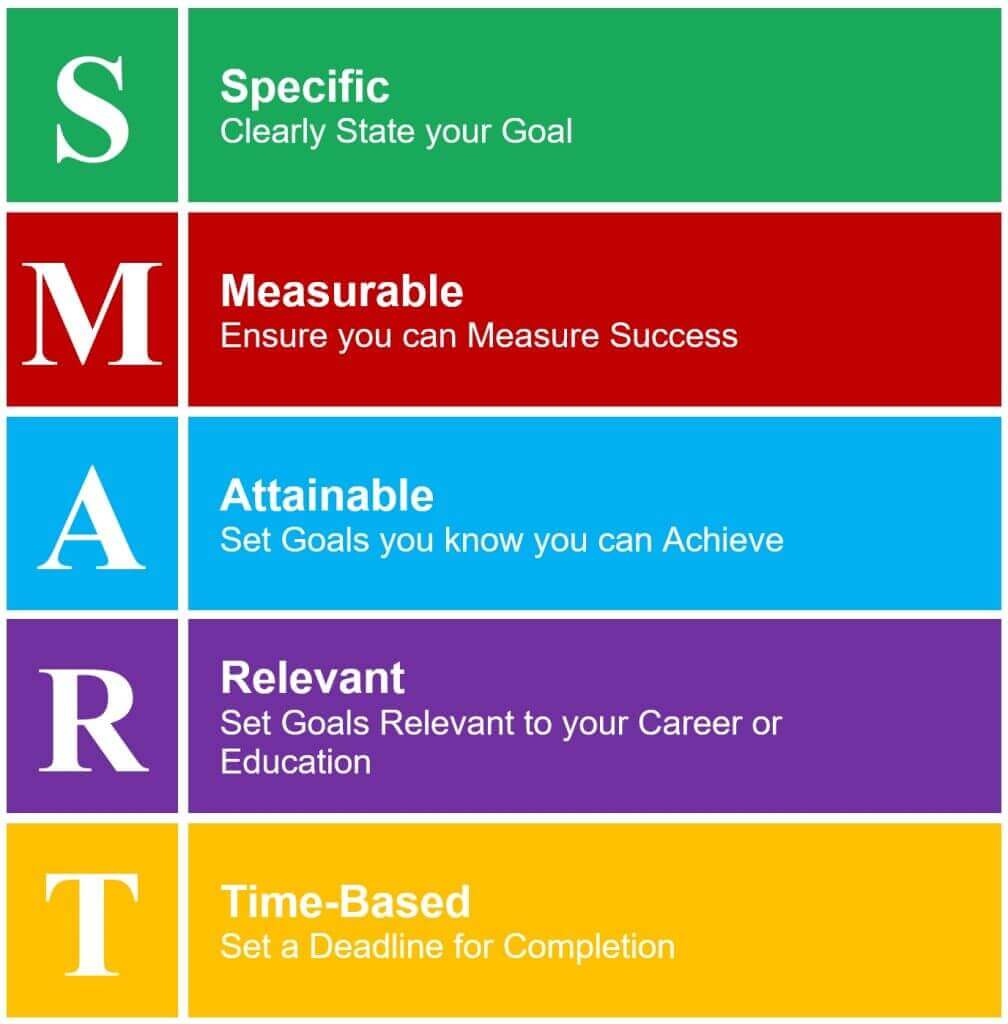Why Is Goal-Setting Important?
Goal-setting is an important part of life. As David McClelland pointed out in 1961, having a sense of achievement is one of the three main sources of motivation for humans(1). What better way to feel a sense of achievement than to actually achieve the goals that you’ve set for yourself?
However, setting goals blindly won’t help either.
You have to hit the sweet spot when it comes to goal-setting. Goals cannot be too easy because you’ll be wasting your potential, and they also have to be attainable so that you won’t get demotivated by an unrealistic target. Here’s where SMART goals come into play.
What Are SMART Goals?
The concept of SMART goals was thought up by George T. Doran. The first mention of this framework was in an article he had written in 1981. In that article, Doran mentioned the benefits of writing SMART goals.
“How do you write meaningful objectives?…Let me suggest therefore, that when it comes to writing effective objectives, corporate officers, managers, and supervisors just have to think of the acronym SMART. Ideally speaking, each corporate, department and section objective should be: (SMART).”
George T. Doran
SMART goals help you to set yourself up for success. These are goals that are Specific, Measurable, Achievable, Realistic, and Timely. By optimizing your goal-setting strategy to be SMART, you’re setting yourself up for success in the long run.
In order for us to start writing SMART goals, let’s dive into what each letter from this acronym means.
Specific
First of all, SMART goals have to be specific. This means that you and your team members have to be aligned on exactly what the team has to achieve.
There are a few ways to help align your team on a common goal. One of which is to use the scrum project management style to ensure that everyone is on the same page in regards to the goal. If you’re working remotely, use this daily stand-up meeting template to help your team stay focused and on track.
Ensuring that everyone knows exactly what to do is critical to ensuring the success of your project.
Measurable
In order to track your progress, you will need to set measurable goals. Setting measurable goals helps to provide you with a gauge of your team’s current performance and progress. Setting a management review at certain points of your project helps you to track if your team is hitting the benchmark, or is falling short of it.
Achievable
One of the easiest ways to hurt you and your team’s morale is by setting unattainable goals. It’s perfectly okay to have a plan for the big leagues. However, you’d be better off if you broke down your stretch goals into smaller achievable steps. In other words, using hierarchical thinking to help you come up with a realistic action plan.
Focus on simpler goals first, and move on to more ambitious projects once your team is in the flow of getting things done.
Relevant
You have to set goals that mean something to you or your company. What’s the point of setting goals just because you have to? The best way to do this is to have an overarching long-term goal which is then broken down into smaller and more actionable sub-goals.
Setting relevant goals is an important aspect of SMART goal setting because it ensures that you’re only setting goals that benefit you and your organization.
Timely
If your goal doesn’t have a deadline, then how are you going to ensure that you achieve it in a timely manner? Goals should be set with a target date of completion in mind. This is so that you can work on it and track your progress at the same time to work towards a target date.
In summary, SMART goals are those that are Specific, Measurable, Achievable, and Relevant, with a due date for completion. The SMART framework is an effective way to help you set better goals for yourself and also your team. But how exactly do you write SMART goals down?
Why Are SMART Goals Important?

SMART goals are important because they help you to set focused goals with a clear direction and timeframe. By following the SMART framework, your team will be clearer about the deliverables and as a result be more productive. Here is a list of benefits that come with SMART goal-setting:
- Helps you set specific and clear goals
- Ensures that you set achievable goals
- Allows you to track your progress
- Helps you set useful goals
- Gives you a deadline to work towards
In a nutshell, SMART goals help by ensuring that you don’t set vague and unrealistic goals for yourself. Using the SMART goal framework helps you to set specific goals that are related to the bigger picture within a certain timeframe.
How to Write Smart Goals
SMART goals are easy to set. But what’s important is for you to get into the habit of using this framework every time you set a new goal.
Here’s how to easily set SMART goals.
- List down the SMART acronym (Specific, Measurable, Achievable, Relevant, Timely)
- Write down your goal and list down how it satisfies each of these criteria
- Specific: Ensure that everyone involved in the project is clear on their role and exactly what they have to achieve
- Measurable: Your goals must be measurable so that you can track performance and progress.
- Achievable: Setting impossible goals will only hurt morale. Make sure that your goal is realistic.
- Relevant: Don’t set goals simply for the sake of it. Make sure that this goal has a direct benefit to your business.
- Timely: Set realistic deadlines so that your team can work with a deadline in mind.
- Use a free SMART goals template to get a headstart in effective goal-setting.
Best Examples of SMART Goals
Now that you understand what the SMART acronym stands for, here are some of the best examples of goals that follow the SMART framework.
Example 1
Goal: I want to write 2 articles per month in order to publish 24 articles this year for my blog.
- Specific: Writing 2 articles per month.
- Measurable: Check if I’m on track to finish 2 articles this month.
- Achievable: Being a freelance writer, this goal is achievable.
- Relevant: I own my own blog, so writing 24 articles is a relevant goal for my blog.
- Timely: I’ve set a deadline to publish 24 articles by this year.
Example 2
Goal: I want to increase my advertising budget by $100 per week so that I can sell 1000 tickets to my event in 2 months.
- Specific: Increasing my ad spend by $100 per week to sell 1000 tickets in 2 months.
- Measurable: Track if I’ve sold at least 500 tickets halfway through the campaign.
- Achievable: I know the conversion rates for online advertisements based on a similar previous campaign, making this an achievable goal.
- Relevant: Selling more tickets would mean that more attendees would be present for my event.
- Timely: I’ve set a deadline to sell 1000 tickets in 2 months.
What Are Some Tips for Writing Better Smart Goals?

Now that you’ve grasped the concept of how to write SMART goals, it’s important that you keep this in mind every time you start on a new project.
Writing goals that are SMART helps you aim for that sweet spot of setting goals that are not impossible to achieve and at the same time not too easy. The next time you start on a new project, write out the SMART acronym and list down how your goals satisfy each of the categories.
Even though this may seem like an additional step to take, it helps you ensure that you’re setting reasonable goals for your project team to achieve.
🤖 Custom AI Agents: Configure AI agents to assist in creating, tracking, and achieving SMART goals across your personal and team projects.
🪄 AI Generator: Describe your aspirations to generate SMART goals that are clear, attainable, and aligned with your timeline and resources.
✏️ AI Assistant: Use GPT-4 Turbo integrated into the project editor to define SMART goals, prioritize tasks, and clarify objectives.
🗂️ AI Prompt Templates Library: Choose from hundreds of AI prompt templates to structure and drive your projects and workflows.
And much more…
🔗Resources
- McClelland, David C., The Achieving Society (1961). University of Illinois at Urbana-Champaign’s Academy for Entrepreneurial Leadership Historical Research Reference in Entrepreneurship, Available at SSRN: https://ssrn.com/abstract=1496181



 How to Use the Method of Loci in 2024 — A Mnemonic Device for Memorization
How to Use the Method of Loci in 2024 — A Mnemonic Device for Memorization  Here’s How Eat the Frog Can Boost Your Productivity in 2024!
Here’s How Eat the Frog Can Boost Your Productivity in 2024!  8 Best AI Tools For Team Productivity
8 Best AI Tools For Team Productivity  Creating AI Agents to Boost Your Coding Efficiency
Creating AI Agents to Boost Your Coding Efficiency  Gantt Charts vs. Roadmaps: Choosing the Right Tool for Your Project
Gantt Charts vs. Roadmaps: Choosing the Right Tool for Your Project  11 Best AI Tools for Writers to Create Content at Scale
11 Best AI Tools for Writers to Create Content at Scale